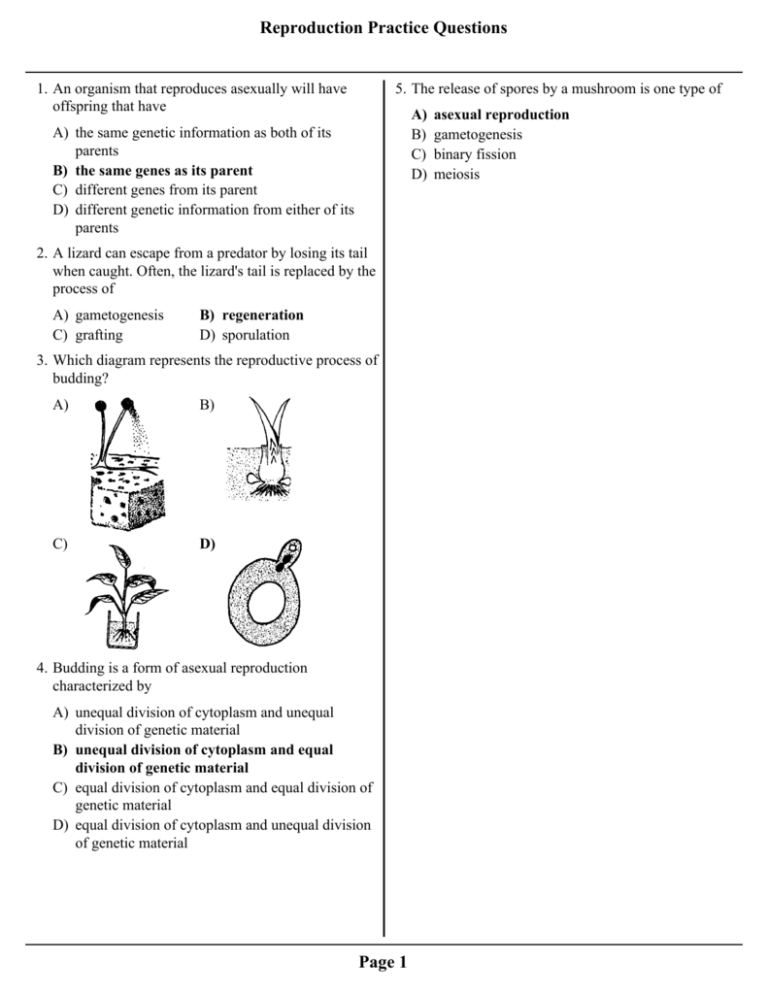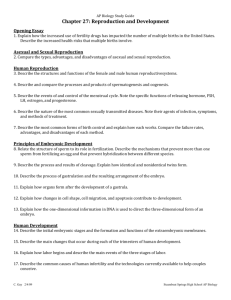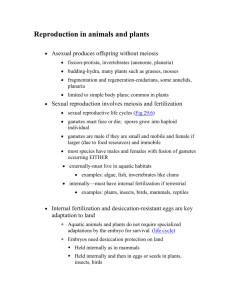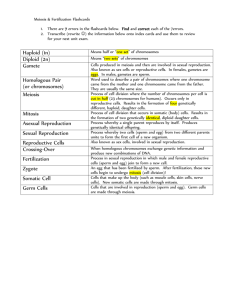Reproduction Practice Questions Page 1
advertisement

Reproduction Practice Questions 1. An organism that reproduces asexually will have offspring that have 5. The release of spores by a mushroom is one type of A) B) C) D) A) the same genetic information as both of its parents B) the same genes as its parent C) different genes from its parent D) different genetic information from either of its parents 2. A lizard can escape from a predator by losing its tail when caught. Often, the lizard's tail is replaced by the process of A) gametogenesis C) grafting B) regeneration D) sporulation 3. Which diagram represents the reproductive process of budding? A) B) C) D) 4. Budding is a form of asexual reproduction characterized by A) unequal division of cytoplasm and unequal division of genetic material B) unequal division of cytoplasm and equal division of genetic material C) equal division of cytoplasm and equal division of genetic material D) equal division of cytoplasm and unequal division of genetic material Page 1 asexual reproduction gametogenesis binary fission meiosis Reproduction Practice Questions 6. Base your answer to the following question on A technique used to reproduce plants is shown in the diagram below. This technique is a form of A) sexual reproduction C) asexual reproduction B) gene manipulation D) sex cell production 7. Strawberries can reproduce by means of runners, which are stems that grow horizontally along the ground. At the region of the runner that touches the ground, a new plant develops. Why is the new plant genetically identical to the parent? 9. Base your answer to the following question on Which process is illustrated in the diagram below? A) there were no other strawberry plants in the area to provide fertilization B) nuclei traveled to the new plant through the runner to fertilize it C) it was produced asexually D) it was produced sexually 8. Which statement is true regarding plants produced by vegetative propagation? A) B) C) D) nuclear fusion sexual reproduction reduction division asexual reproduction 10. Which diagram represents binary fission? A) They normally obtain most of their nourishment from the seed. B) They are normally genetically identical to the parent. C) They normally have the monoploid number of chromosomes. D) They normally exhibit only dominant characteristics. Page 2 A) C) B) D) Reproduction Practice Questions 11. Which process allows a mammal to continue to grow 13. Base your answer to the following question on A in size? photomicrograph of cells involved in various stages of nuclear division is shown below. A) mitosis of body cells B) meiosis of body cells C) meiosis of sex cells D) mitosis of sex cells 12. The number in each circle below represents the chromosome number of the cell. Which diagram represents the production of offspring by an asexually reproducing organism A) B) Which title is most appropriate for this photomicrograph? A) B) C) D) C) Gametogenesis in Yeast Cells Cell Division in Human Blood Cells Meiosis in Male Gametes Mitosis in an Onion Root Tip 14. Which mitotic event in the chart below occurs after the other three events have taken place? D) A) A B) B C) C D) D 15. The chromatids of a double-stranded chromosome are held together at a region known as the A) polar body C) Golgi complex Page 3 B) centriole D) centromere Reproduction Practice Questions 16. A student using a compound light microscope is observing cells undergoing mitotic cell division. If the cells are from a bean plant, which process could the student observe? 20. Base your answer to the following question on The diagram below represents stages in the processes of reproduction and development in an animal. A) the formation of a cell plate between two new cells B) the replication of centrioles C) the pairing of homologous chromosomes D) a pinching-in of the cell membrane to form two cells 17. Base your answer to the following question on the diagrams below. Cells containing only half of the genetic information characteristic of this species are found at A) B B) D C) A D) C 21. A sperm cell from an organism is represented in the diagram below. Which diagram shows the formation of a cell plate? A) A B) B C) C D) D 18. Uncontrolled cell division is a characteristic of A) cancer C) regeneration B) oogenesis D) cleavage 19. The diagram below represents structures found in a human female. Which statement regarding this sperm cell is not correct? Which process results in the formation of structure X? A) cloning C) meiosis B) recombination D) mitosis Page 4 A) Energy to move the flagellum originates in the middle piece. B) The acrosome contains half the normal number of chromosomes. C) The head may contain a mutation. D) This cell can unite with another cell resulting in the production of a new organism. Reproduction Practice Questions 22. Base your answer to the following question on The distribution of chromosomes in one type of cell division is shown in the diagram below. A) B) C) D) mitosis asexual reproduction meiosis vegetative propagation 23. Which process produces polar bodies that eventually degenerate? A) cleavage C) spermatogenesis B) cyclosis D) oogenesis genetic variability of offspring large numbers of gametes increasingly complex multicellular organisms cloning of superior offspring 28. A sperm cell of an alligator has 16 chromosomes. What is the total number of chromosomes normally present in a stomach cell of this alligator? A) 48 24. The process of meiotic cell division in a human male usually forms A) B) C) D) A) Adaptive traits are usually passed from parent to offspring without genetic modification. B) It always enables organisms to survive in changing environmental conditions. C) Mutations are not passed from generation to generation. D) It is responsible for many new variations in offspring. 27. Meiosis and fertilization are important for the survival of many species because these two processes result in Which process is represented in the diagram? A) B) C) D) 26. Which statement describes asexual reproduction? B) 32 C) 8 D) 16 29. The diagram below shows stages of human reproduction. four diploid cells one monoploid cell, only one diploid cell, only four monoploid cells 25. Which two structures of a frog would most likely have the same chromosome number? A) B) C) D) zygote and sperm cell kidney cell and egg cell skin cell and fertilized egg cell liver cell and sperm cell The direct result of fertilization is represented at A) A Page 5 B) B C) C D) D Reproduction Practice Questions 30. Which characteristic of sexual reproduction has specifically favored the survival of animals that live on land? A) B) C) D) 35. The chart below summarizes data obtained from the observation of eggs of three animal species: A, B, and C. fusion of gametes in the outside environment fertilization within the body of the female male gametes that may be carried by the wind female gametes that develop within ovaries 31. An adaptation that has enabled animals to reproduce successfully on land is A) B) C) D) fertilization outside the body of the female egg cells with the ability to locomote diploid gametes that undergo differentiation semen as a transport medium for sperm 32. A characteristic of fertilization in most terrestrial vertebrates is the A) fusion of gametes in a moist internal environment B) release of thousands of eggs C) release of nonmotile sperm D) fusion of gametes in a dry external environment 33. Which reproductive adaptation is characteristic of most terrestrial vertebrates but not of most aquatic vertebrates? A) B) C) D) motile gametes external fertilization external development internal fertilization 34. With which type of organism does external fertilization occur most often? A) B) C) D) mammals and birds reptiles and birds amphibians and reptiles fish and amphibians Page 6 External fertilization most likely occurs in species A) A, only C) C, only B) A and C D) B and C Reproduction Practice Questions 36. Base your answer to the following question on Which phrase best describes a process represented in the diagram below? A) a gamete dividing by meiosis C) a zygote dividing by meiosis B) a gamete dividing by mitosis D) a zygote dividing by mitosis 37. Whick term describing the series of rapid cell divisions that occur immediately after zygote formation? A) differentiation C) fertilization 41. A third cell layer in the human embryo is formed during the A) gastrula stage C) blastula stage B) cleavage D) meiosis 38. Base your answer to the following question on the diagram below and on your knowledge of biology. The arrows in the diagram represent processes. B) zygote stage D) cleavage stage 42. Base your answer to the following question on the diagrams below and on your knowledge of biology. Which process is represented by letter A? A) synapsis C) spermatogenesis B) ovulation D) cleavage 39. Although a liver cell and a muscle cell in a human developed from the same single cell, their appearance and functions are different. This is because the liver cell A) B) C) D) expresses different genes than the muscle cell destroys the muscle cell genes it contains lacks the genes found in muscle cells contains different genes than the muscle cell Which diagram shows the first appearance of the distinct layer of cells that will form the muscular, skeletal, and circulatory systems? A) 11 B) 8 C) 6 40. The diagram below represents early stages of embryo development. The greatest amount of differentiation for organ formation most likely occurs at arrow A) A B) B C) C D) D Page 7 D) 4 Reproduction Practice Questions 43. Which sequence represents the correct order of events in the development of sexually reproducing animals? 47. Which type of fertilization and development occurs in the life cycle of the organisms represented below? A) cleavage ® fertilization ® growth ® differentiation B) fertilization ® differentiation ® cleavage ® growth C) fertilization ® cleavage ® differentiation ® growth D) growth ® cleavage ® fertilization ® differentiation 44. Most mammals have adaptations for A) internal fertilization and internal development of the fetus B) external fertilization and internal development of the fetus C) external fertilization and external development of the fetus D) internal fertilization and external development of the fetus A) external fertilization and external development B) internal fertilization and external development C) external fertilization and internal development D) internal fertilization and internal development 48. Which situation would be part of the normal reproductive cycle of a human? 45. The structure that makes nutrients most directly available to a human embryo is the A) placenta C) stomach B) gamete D) ovary 46. In most animal species with internal development, the embryo becomes implanted in the lining of the A) liver C) uterus B) ovary D) stomach Page 8 A) a low insulin level in either a male or a female B) a high progesterone level in a male C) estrogen in concentrations that would produce sperm in a female D) the presence of testosterone regulating gamete production in a male Reproduction Practice Questions 49. Base your answer to the following question on the diagram below and on your knowledge of biology. The letters in the diagram indicate structures present in a human male. 52. Base your answer to the following question on The diagram below represents a human reproductive system. Meiosis occurs within structure What change would occur immediately if both structures labeled B were damaged or blocked? A) B A) Gametes would no longer be transported to structure C. B) Structure D would be able to deliver more gametes. C) Structure A would decrease in size. D) The blood supply to structure E would decrease . B) C C) A D) D 53. Base your answer to the following question on the diagram below, which represents a necessary part of human reproduction. Base your answers to questions 50 and 51 on on the picture below which represents systems in a human male and on your knowledge of biology. In humans, this process is most influenced by the presence of 50. Which structure has both reproductive and excretory functions? A) A B) G C) C A) egg cells C) thyroxin D) D 51. Which sequence represents the path of sperm leaving the body? A) C) B) D) Page 9 B) progesterone D) testosterone Reproduction Practice Questions 54. The scrotum is an important adaptation in human males because the optimum temperature for sperm development is A) 2 to 4 degrees below normal body temperature B) 10 to 12 degrees above normal body temperature C) 2 to 4 degrees above normal body temperature D) 10 to 12 degrees below normal body temperature 55. Hormones produced by the testes control the expression of traits for A) B) C) D) beard development and number of fingers voice quality and beard development hair color and voice quality hair color and eye color Base your answers to questions 56 and 57 on the diagram below and on your knowledge of biology. The diagram represents the human female reproductive system. 56. The placenta forms from the combination of fetal tissue and tissue from structure A) D B) A C) B D) C 57. Structure A usually produces A) B) C) D) testosterone and eggs estrogen, progesterone, and testosterone estrogen, progesterone, and eggs sperm and eggs Page 10 Reproduction Practice Questions 58. Base your answer to the following question on the diagram below and on your knowledge of biology. The diagram represents the reproductive systems of the human female and male. In which structure do gametes usually unite to produce a zygote? A) A B) G C) C D) F 59. In most mammals, the placenta is essential to the embryo for the processes of A) B) C) D) 62. Which sequence represents the normal order of events that occur during the menstrual cycle? milk production and digestion nutrition and excretion meiosis and excretion blood exchange and digestion A) menstruation ® ovulation ® corpus luteum ® follicle stage B) follicle stage ® ovulation ® corpus luteum ® menstruation C) follicle stage ® menstruation ® corpus luteum ® ovulation D) ovulation ® follicle stage ® corpus luteum ® menstruation 60. The human reproductive system is regulated by A) B) C) D) hormones complex carbohydrates sex cells enzymes 61. Base your answer to the following question on the diagram below, which represents the human female reproductive system. In which part of this system does a fetus usually develop? A) A B) B C) C D) D Page 11 Reproduction Practice Questions 63. Base your answer to the following question on The diagram below represents a sequence of events in a human ovary. 67. It usually will not occur if a zygote is formed during the cycle. A) 1 B) 2 C) 3 D) 4 68. A mature egg is released. A) 1 B) 2 C) 3 D) 4 69. A temporary suspension of the menstrual cycle normally occurs during A) pregnancy C) menopause B) menstruation D) ovulation 70. Identical twins develop from A) one egg, fertilized by one sperm cell B) two eggs, both fertilized by the same sperm cell C) one egg, fertilized by two separate sperm cells D) two eggs, each fertilized by a separate sperm cell The process that occurs between stage A and stage B is known as A) spermatogenesis C) regeneration B) oogenesis D) budding 71. The drinking of alcoholic beverages by a pregnant woman is harmful to the development of her fetus. This is most damaging early in a pregnancy because during this time 64. The ovary releases an egg in a process known as A) ovulation C) implantation B) gestation D) fertilization 65. As women age, their reproductive cycles stop due to decreased A) B) C) D) production of ATP digestive enzyme production heart rate levels of specific hormones Base your answers to questions 66 through 68 on the stage of the human menstrual cycle, chosen from the list below, that is most closely associated with that statement. Stages of the Human Menstrual Cycle (1) Follicle (2) Ovulation (3) Corpus luteum (4) Menstruation 66. It is characterized by a yellow-bodied structure that secretes the hormone progesterone. A) 1 B) 2 C) 3 D) 4 Page 12 A) B) C) D) the fetus cannot excrete wastes alcohol can easily enter the mouth of the fetus the lungs of the fetus become functional many of the essential organs of the fetus are forming Reproduction Practice Questions 72. Base your answer to the following question on the diagram below, which represents a necessary part of human reproduction. 74. Base your answer to the following question on the diagram below, which represents a human embryo developing in the uterus, and on your knowledge of biology. The embryo is protected from shock by a substance located at A) 6 B) 7 C) 3 Structure 3 represents the D) 4 A) membrane that protects the embryo from mechanical shock B) site of exchange of materials between the mother and the fetus C) structure that stores yolk for the developing fetus D) site where the female gametes undergo meiosis during maturation 73. Most of the skeleton of a human embryo is composed of connective tissue known as A) cartilage C) tendons B) ligaments D) bone 75. In humans, the period of development before birth is known as A) fertilization C) menstruation Page 13 B) gestation D) pollination Answer Key Reproduction Practice Q's 1. B 36. D 71. D 2. B 37. B 72. B 3. D 38. D 73. A 4. B 39. A 74. B 5. A 40. D 75. B 6. C 41. A 7. C 42. A 8. B 43. C 9. D 44. A 10. B 45. A 11. A 46. C 12. D 47. A 13. D 48. D 14. B 49. A 15. D 50. B 16. A 51. C 17. D 52. D 18. A 53. D 19. C 54. A 20. C 55. B 21. B 56. D 22. C 57. C 23. D 58. A 24. D 59. B 25. C 60. A 26. A 61. D 27. A 62. B 28. B 63. B 29. C 64. A 30. B 65. D 31. D 66. C 32. A 67. D 33. D 68. B 34. D 69. A 35. A 70. A Page 14








